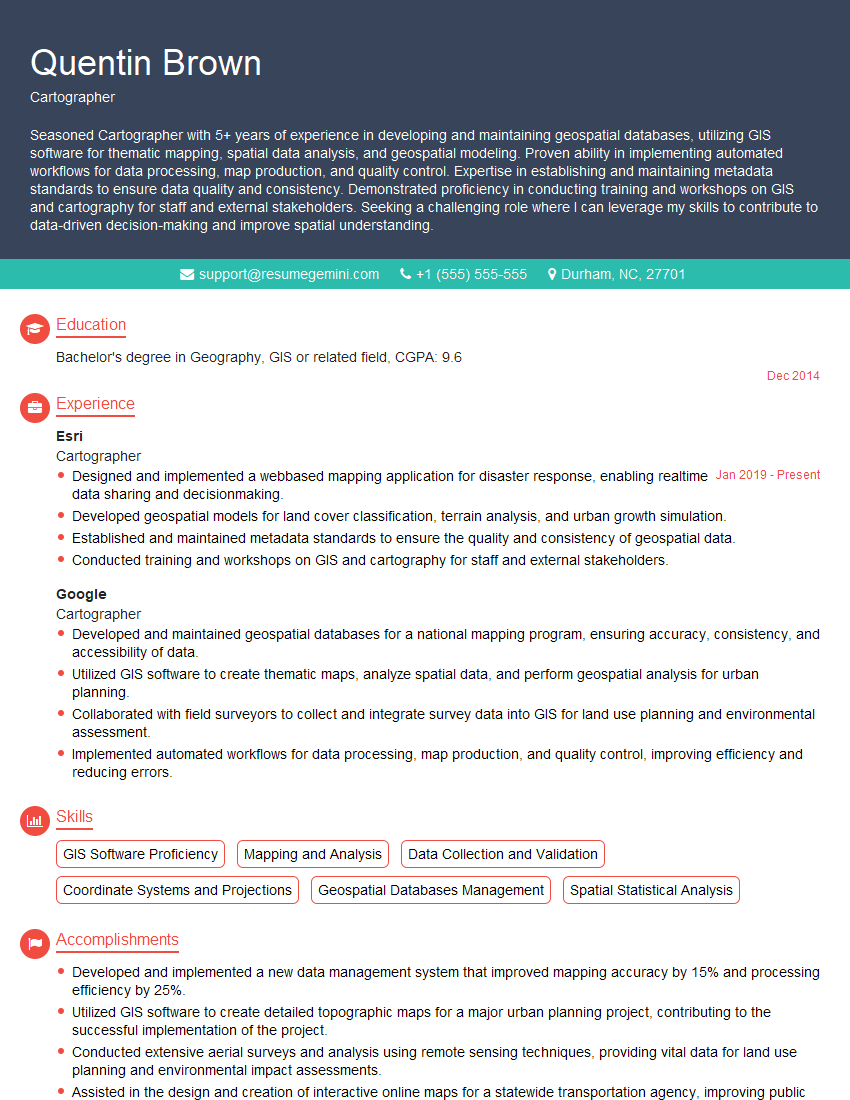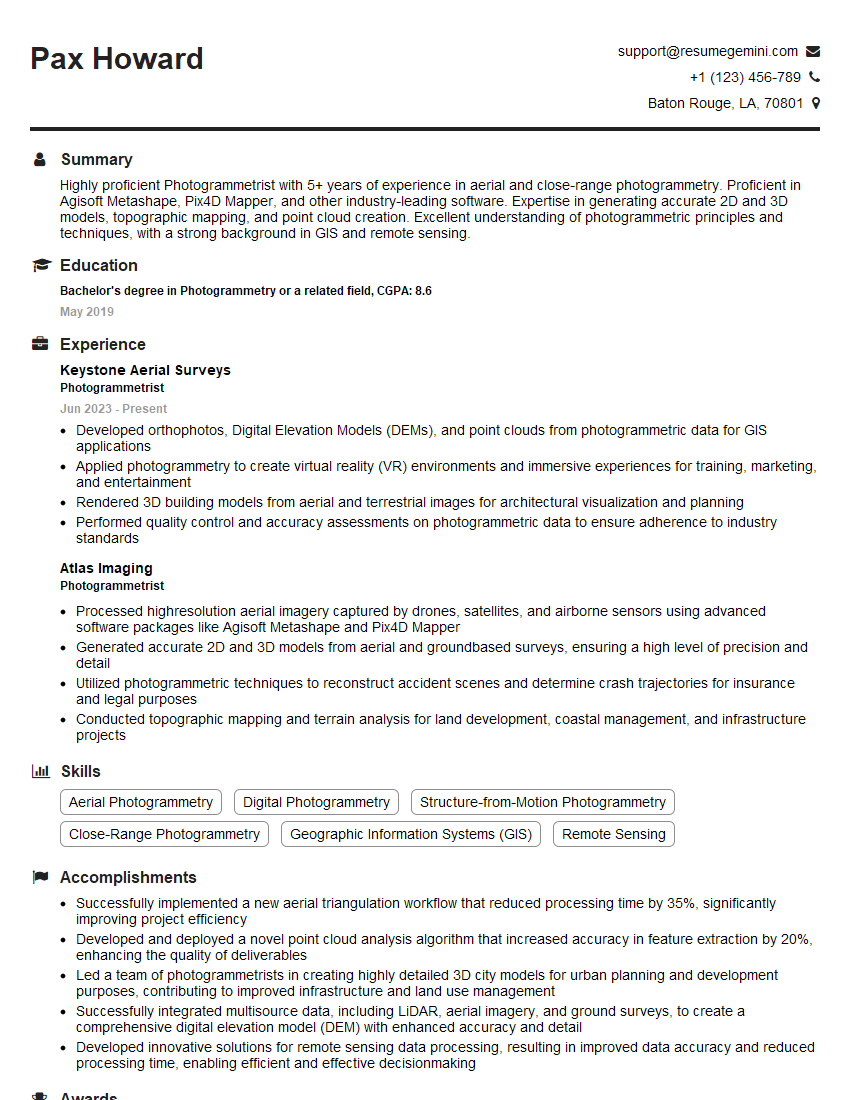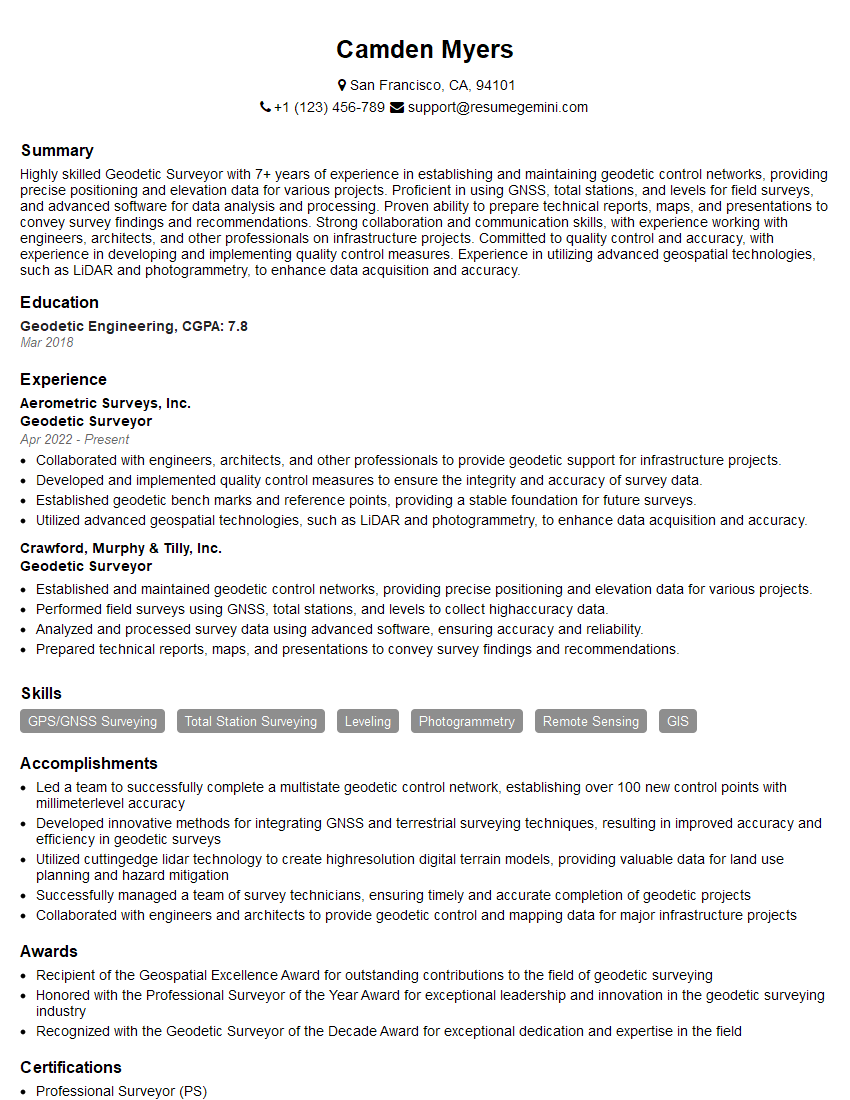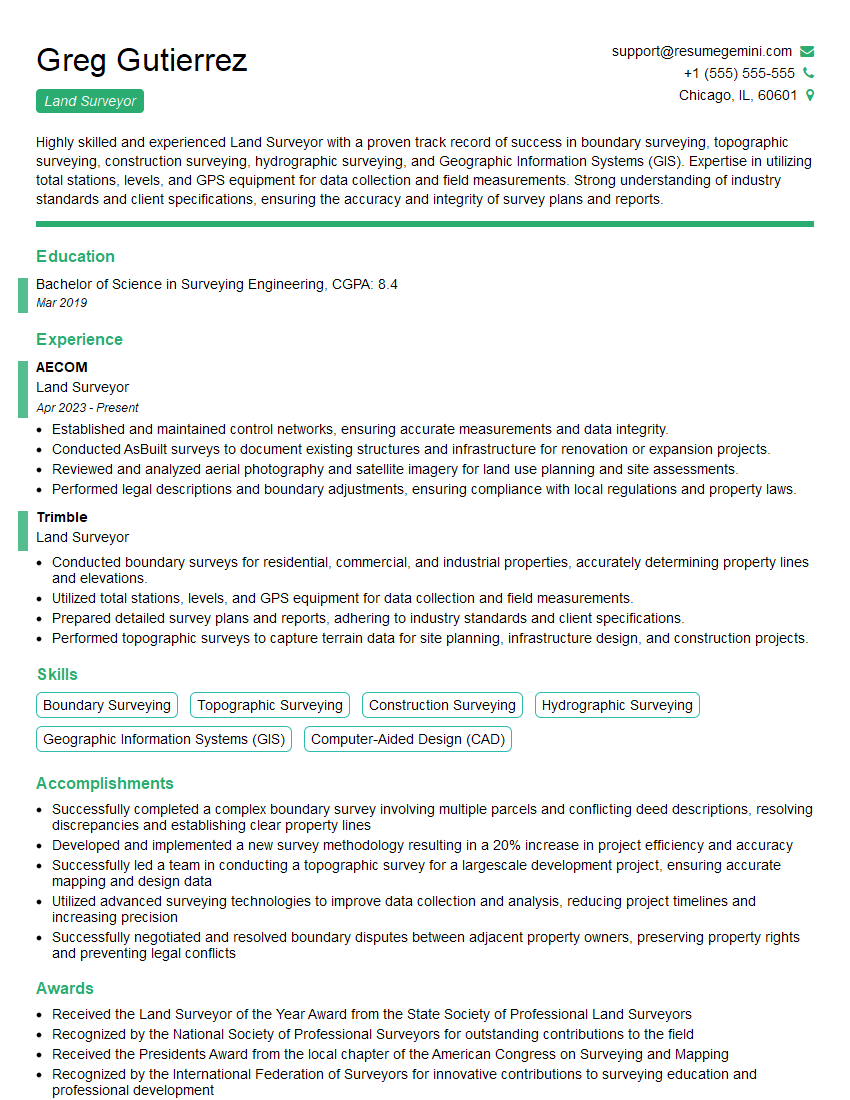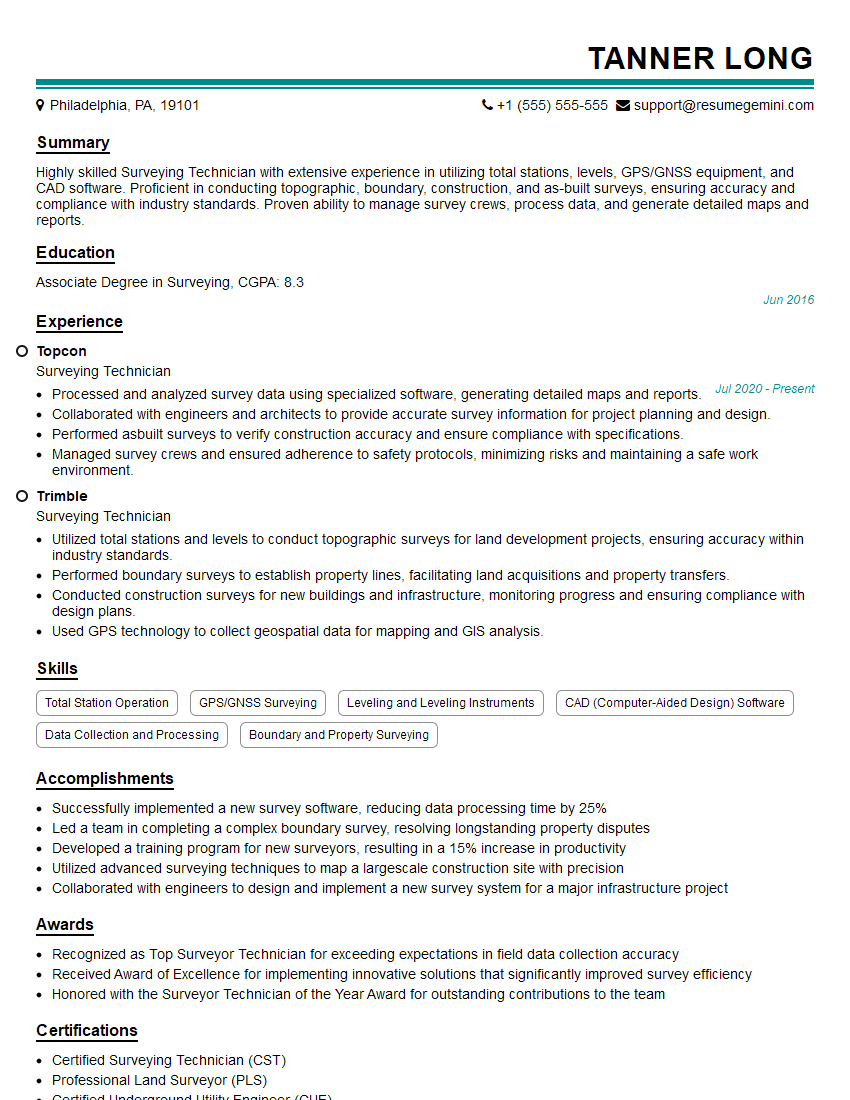The thought of an interview can be nerve-wracking, but the right preparation can make all the difference. Explore this comprehensive guide to Vertical Control interview questions and gain the confidence you need to showcase your abilities and secure the role.
Questions Asked in Vertical Control Interview
Q 1. Explain the concept of vertical control in surveying.
Vertical control in surveying refers to the process of establishing and monitoring elevations or heights of points on the Earth’s surface. It’s like creating a three-dimensional framework, providing a vertical reference system for all other surveying measurements. Accurate vertical control is crucial for various applications, including engineering design (roads, buildings, dams), construction, mapping, and monitoring land subsidence or uplift. Imagine building a skyscraper – you need precise vertical control to ensure every floor aligns perfectly!
Q 2. What are the different methods used for establishing vertical control?
Several methods exist for establishing vertical control, each with varying degrees of precision and cost. The most common methods include:
- Spirit Leveling (Precise Leveling): This method utilizes a level instrument and leveling rod to measure differences in elevation between points. It’s highly accurate for short to medium distances.
- Trigonometric Leveling: This involves measuring vertical angles and distances using a theodolite and EDM (Electronic Distance Measurement). It’s suitable for longer distances where precise leveling is impractical or costly.
- GPS/GNSS Leveling: Global Navigation Satellite Systems (GNSS) like GPS can provide three-dimensional positioning, including elevation. While becoming increasingly precise, it’s often used in conjunction with other methods for precise vertical control.
- Barometric Leveling: This method uses barometric pressure to determine elevation. It’s less precise than other methods and suitable for quick, approximate elevation estimations over larger areas.
Q 3. Describe the process of leveling and its importance in vertical control.
Leveling is the process of determining the difference in elevation between two or more points using a level instrument and leveling rod. A level instrument, essentially a very precise spirit level, ensures the line of sight is horizontal. The leveling rod is graduated and held vertically at each point. The instrument operator reads the rod’s height, and the difference in readings between two points provides the difference in elevation.
Its importance in vertical control is paramount because it forms the backbone of most precise vertical networks. It provides the foundational data to establish benchmarks and create accurate elevation models, vital for numerous applications.
The process typically involves setting up the level instrument roughly equidistant from two points, taking readings on the rods, and repeating the process along a series of points to determine the elevation differences.
Q 4. What are benchmark and its purpose in vertical control networks?
A benchmark is a permanently marked point of known elevation. It serves as a reference point in a vertical control network. Imagine them as anchors for your vertical measurements. They can be anything from a brass plate set in concrete to a naturally occurring feature (rock outcropping) whose elevation is precisely determined. The purpose of benchmarks is to provide stable, reliable points for future surveys, allowing surveyors to easily re-establish elevations and tie new surveys to the existing network. They are critical for maintaining consistency and accuracy over time and across different projects.
Q 5. Explain the difference between precise leveling and trigonometric leveling.
Precise leveling (or spirit leveling) and trigonometric leveling are distinct methods with differing approaches and accuracies:
- Precise Leveling: Uses a level instrument to establish a horizontal line of sight directly between points. It’s highly accurate, particularly over short to medium distances, minimizing errors associated with vertical angles. Think of it as measuring height differences directly.
- Trigonometric Leveling: Measures vertical angles and distances using a theodolite and EDM. The elevation difference is calculated using trigonometry. While suitable for long distances where precise leveling is impractical, it’s less accurate due to the increased influence of atmospheric refraction and instrumental errors. Think of it as calculating height differences indirectly using angles and distances.
In essence, precise leveling is more accurate for shorter distances, whereas trigonometric leveling is necessary for longer distances where direct leveling is not feasible.
Q 6. How do you account for curvature and refraction in leveling?
Curvature and refraction are atmospheric effects that affect the line of sight in leveling. The Earth’s curvature causes the line of sight to be above the geoid (the Earth’s mean sea level surface), while atmospheric refraction bends the line of sight downwards due to variations in air density. Both effects introduce errors in elevation measurements.
These effects are usually accounted for through:
- Correction Formulas: Standard formulas exist to calculate the correction for curvature and refraction based on the distance between points. These corrections are applied to the observed difference in elevation.
- Reciprocal Leveling: This technique involves leveling between two points from both ends. The mean of the two elevation differences helps to minimize the combined effect of curvature and refraction.
- Minimizing Distances: By keeping the distance between instrument and rod relatively short, the effects of curvature and refraction are reduced, minimizing the need for extensive corrections.
Q 7. What are the sources of error in leveling and how can they be minimized?
Several sources of error can affect leveling accuracy:
- Instrumental Errors: Misalignment of the level, collimation errors (the line of sight not being perfectly horizontal), and errors in the leveling rod graduations.
- Personal Errors: Incorrect rod readings, improper instrument setup, and mistakes in recording data.
- Natural Errors: Curvature and refraction of light, ground settlement or movement, and temperature effects on the instrument and rod.
Minimizing these errors involves:
- Proper Instrument Calibration and Maintenance: Regularly check and adjust the level instrument to ensure accuracy.
- Careful Setup and Procedures: Follow established leveling procedures meticulously, ensuring proper instrument setup and rod placement.
- Redundant Measurements: Take multiple readings and use techniques like reciprocal leveling to identify and reduce errors.
- Environmental Considerations: Conduct leveling during favorable atmospheric conditions (calm weather) to minimize the effects of refraction.
- Data Checking and Analysis: Thoroughly review recorded data for inconsistencies and apply appropriate corrections.
Q 8. Describe different types of leveling instruments and their applications.
Leveling instruments are crucial for establishing vertical control, measuring differences in elevation between points. Several types exist, each with its own strengths and weaknesses.
- Automatic Levels: These are the workhorses of leveling, using a compensator to automatically level the line of sight. They’re fast, accurate, and ideal for most leveling tasks. Think of them as self-correcting spirit levels on steroids. An example is the Leica Sprinter series.
- Digital Levels: Combine the ease of use of automatic levels with digital readout. This eliminates the need for reading a scale, reducing human error and speeding up the process. They often include built-in data logging capabilities.
- Precise Levels: These are high-precision instruments used for demanding applications requiring very high accuracy, such as geodetic leveling or precise engineering surveys. They may use a micrometer for fine adjustments and are generally more sensitive to environmental conditions.
- Tilting Levels: While less common now, tilting levels require manual leveling using a circular level and adjusting screws. They are simpler in design but require more skill to operate accurately.
Applications: The choice of instrument depends on the project. Automatic levels are used for construction surveys, topographic mapping, and setting benchmarks. Digital levels are excellent for large projects requiring efficient data collection. Precise levels are vital where extreme accuracy is critical, such as in deformation monitoring or establishing national height networks.
Q 9. How do you perform a loop closure in leveling and what does it indicate?
Loop closure in leveling is a crucial quality control check. It involves establishing a level loop—a series of leveling measurements that begins and ends at the same benchmark. Imagine walking a closed square, measuring the height differences of each side. When you return to your starting point, the total elevation change should ideally be zero.
Procedure: Leveling is performed between a series of points, recording the height difference (rise or fall) between each. The loop is completed by returning to the starting benchmark. The difference between the initial elevation and the final elevation (after completing the loop) is the loop closure error.
Significance: A small loop closure error indicates good accuracy in the leveling work, within acceptable tolerances based on the instrument precision and distance covered. A large error suggests mistakes in the measurements (e.g., incorrect readings, instrument malfunction), or possible settlement of benchmarks. The error is then distributed throughout the loop using a proportional adjustment method to ensure the height differences are consistent and correct. This process essentially refines the height values to account for the closure error.
Q 10. Explain the concept of orthometric height and ellipsoidal height.
Both orthometric and ellipsoidal heights represent vertical positions but use different reference surfaces.
Ellipsoidal height (h): This is the height above the ellipsoid, a mathematical approximation of the Earth’s shape. Think of it like the distance measured vertically straight up from a smooth, slightly squashed ball representing Earth. It’s obtained directly from GNSS measurements. The ellipsoid itself is a simple shape that is chosen as a best-fitting surface to the earth’s geoid. Different ellipsoids are chosen for certain applications and regions.
Orthometric height (H): This is the height above the geoid, a surface that represents mean sea level (MSL). It’s the height you’d typically use in everyday life, as it reflects the actual physical height above the Earth’s surface, as opposed to the mathematical height from an imaginary ellipsoid. Orthometric heights are determined through leveling.
The key difference: Ellipsoidal heights are referenced to a mathematical surface, while orthometric heights are referenced to the geoid, a physical approximation of the earth’s equipotential surface. The difference between these heights is known as the geoid undulation.
Q 11. What is a geoid and how does it relate to vertical datum?
The geoid is an equipotential surface that closely approximates mean sea level (MSL) and is used as a reference surface for orthometric heights. Imagine the global ocean at rest, extending under the continents. The geoid would represent the shape of that extended surface, taking into account gravitational variations and the Earth’s uneven shape.
Relationship to Vertical Datum: A vertical datum defines the reference surface for elevations. Many vertical datums are based on the geoid; they define a specific realization of the geoid model for a particular area. The North American Vertical Datum of 1988 (NAVD88), for instance, uses a specific geoid model to define its reference surface.
In essence, the geoid is the natural physical reference, while the vertical datum is a specific, mathematically defined realization of it for practical use in surveying and mapping.
Q 12. What are the various vertical datums used and their differences?
Various vertical datums exist worldwide, each with a different geoid model and reference surface. This leads to inconsistencies in elevation values between different datums.
- North American Vertical Datum of 1988 (NAVD88): Widely used in North America. It’s based on a geoid model and uses a network of leveled benchmarks for precise height determination. Its most widely used vertical reference point is called the Mean Sea Level.
- European Vertical Reference System 1989 (EVRS): Used in Europe. Like NAVD88, it is defined through precise leveling and a detailed geoid model. It seeks to connect its reference surface to Mean Sea Level using the Tide Gauge.
- Other national and regional datums: Many countries have their own vertical datums, often based on regional mean sea level observations. These can vary significantly depending on local geoid variations and historical measurement practices.
Differences: The main difference lies in the choice of geoid model and the specific benchmarks used to define the datum. This leads to differences in elevation values, even for the same point on Earth, when referenced to different datums. Transformations between different datums are necessary to ensure consistency.
Q 13. Explain the concept of vertical datum transformation.
Vertical datum transformation is the process of converting elevations from one vertical datum to another. Since different datums use different reference surfaces, elevations measured in one datum will be different than in another. This conversion is crucial for integrating data from various sources and for ensuring consistency in spatial analysis.
Methods: Transformations can be performed using various methods, including:
- Grid-based transformations: These use gridded data representing the difference between two datums. A specific grid point closest to the location of interest is used for the transformation.
- Geoid-based transformations: These use geoid height models to directly convert ellipsoidal heights to orthometric heights and vice-versa. This requires having accurate geoid models for both the source and target datums.
- Polynomial transformations: These use mathematical equations to represent the transformation, typically based on a least-squares fit of points that are referenced by both datums.
Importance: Accurate datum transformation is essential for integrating data from various sources, such as older maps and new surveys, and for avoiding errors in engineering projects, environmental modeling, and other applications.
Q 14. How do GPS and GNSS contribute to vertical control?
GPS (Global Positioning System) and GNSS (Global Navigation Satellite Systems) provide a significant contribution to vertical control. Although primarily known for horizontal positioning, GNSS measurements provide ellipsoidal heights directly.
Contributions:
- Direct measurement of ellipsoidal height: GNSS receivers measure the distance to satellites and use this data to compute the receiver’s position in three dimensions, including its height above the reference ellipsoid. These heights can then be converted to orthometric heights using a geoid model.
- Establishing height reference points: GNSS data can be used to establish new height reference points, which can be used to supplement and improve the accuracy of leveling networks. High-accuracy GNSS methods can deliver precise heights, often used to supplement leveling, particularly in locations where leveling is difficult.
- Rapid data acquisition: GNSS allows for the rapid acquisition of elevation data over large areas, making it useful for large-scale mapping and topographic surveys.
However, GNSS-derived heights are affected by atmospheric conditions and satellite geometry, and require careful processing and correction techniques for optimal accuracy. Therefore they’re very effective when integrated with more traditional leveling techniques.
Q 15. Describe the use of total stations in establishing vertical control.
Total stations are invaluable tools in establishing vertical control. They combine electronic distance measurement (EDM) with an electronic theodolite to precisely measure both horizontal and vertical angles and distances. In vertical control, the key is determining elevations accurately. A total station achieves this by measuring the vertical angle to a target of known or assumed height and the slope distance between the instrument and the target. Using trigonometry, specifically the calculation involving the vertical angle and the slope distance, the instrument can compute the height difference between the instrument and the target. By knowing the height of the instrument, the elevation of the target point is then calculated. This process is repeated for multiple points, creating a network of interconnected elevations forming the vertical control framework.
For instance, imagine surveying a construction site. The total station, set up at a known benchmark (a point with a precisely determined elevation), can accurately measure the elevations of various points on the site, including the proposed building’s corners, ensuring proper foundation levels and overall construction accuracy. These elevations, established through the total station, serve as the basis for all subsequent height measurements on the project.
Career Expert Tips:
- Ace those interviews! Prepare effectively by reviewing the Top 50 Most Common Interview Questions on ResumeGemini.
- Navigate your job search with confidence! Explore a wide range of Career Tips on ResumeGemini. Learn about common challenges and recommendations to overcome them.
- Craft the perfect resume! Master the Art of Resume Writing with ResumeGemini’s guide. Showcase your unique qualifications and achievements effectively.
- Don’t miss out on holiday savings! Build your dream resume with ResumeGemini’s ATS optimized templates.
Q 16. Explain the concept of height uncertainty and its importance.
Height uncertainty, often expressed as standard error or a confidence interval, represents the level of imprecision in an elevation measurement. It acknowledges that every measurement contains some degree of error stemming from instrument limitations, atmospheric conditions, and human error. Understanding height uncertainty is crucial because it directly impacts the reliability of engineering designs, construction projects, and scientific analyses that rely on these elevations.
For example, a large height uncertainty in the elevation of a dam’s spillway could lead to miscalculations in water management, potentially causing serious consequences. Similarly, inaccurate elevations in infrastructure projects could result in costly rework or safety hazards. Therefore, minimizing height uncertainty through careful planning, precise measurements, and rigorous quality control is paramount.
Q 17. How do you handle discrepancies in vertical control measurements?
Discrepancies in vertical control measurements arise from various sources, including instrument errors, atmospheric refraction, and human mistakes. Handling these discrepancies requires a systematic approach. First, identify the magnitude of the discrepancy. Small discrepancies, usually within acceptable tolerances defined by project specifications, might be simply adjusted through least squares adjustment. This is a mathematical technique that minimizes the overall error in the network by distributing the discrepancies across multiple points in a statistically sound way.
Larger discrepancies, however, necessitate a more thorough investigation. This could involve re-measuring the affected sections, checking instrument calibration, reviewing field notes for potential errors, and even considering external factors like atmospheric conditions during the measurements. If the source of the discrepancy cannot be identified and resolved, the data point may need to be rejected, and the vertical control network recalculated.
Imagine a situation where the elevation of a benchmark derived from two independent survey lines significantly differ. Before discarding either measurement, it is essential to retrace the steps involved in both measurements and investigate potential sources of error.
Q 18. What are the quality control measures for vertical control surveys?
Robust quality control measures are indispensable in vertical control surveys. These measures ensure the reliability and accuracy of the final elevations. They include:
- Instrument Calibration: Regular calibration of total stations and leveling instruments to minimize instrumental errors.
- Redundant Measurements: Taking multiple measurements of the same point from different positions or using different methods to identify and mitigate errors.
- Loop Closure: Designing survey networks in loops to check the consistency of measurements. Significant closure errors indicate potential problems needing investigation.
- Benchmark Stability Check: Periodically checking the stability of established benchmarks to account for any ground movement or changes that might affect their elevation.
- Environmental Considerations: Accounting for atmospheric conditions (temperature, pressure, humidity) and their impact on measurements using appropriate corrections.
- Data Validation: Rigorous checks on the data before and after processing to identify any outliers or inconsistencies.
By adhering to these measures, surveyors build confidence in the accuracy and reliability of their vertical control network.
Q 19. Describe the role of software in processing vertical control data.
Specialized software plays a vital role in processing vertical control data, automating tedious calculations and enhancing efficiency. These software packages perform various functions, including:
- Data Import and Editing: Importing raw data from total stations and other instruments and allowing for data editing and quality control.
- Least Squares Adjustment: Applying mathematical methods to adjust the observed elevations, minimizing the overall errors and producing a consistent network.
- Error Analysis: Providing statistical analysis of the measurements, revealing patterns and indicating potential sources of error.
- Coordinate Transformation: Transforming coordinates between different coordinate systems or datums.
- Report Generation: Producing comprehensive reports summarizing the survey results, including elevations, uncertainties, and quality control information.
For example, software like AutoCAD Civil 3D or Leica Geo Office allows for the efficient processing of large datasets, complex network adjustments, and the creation of detailed drawings, streamlining the entire vertical control workflow significantly.
Q 20. What are the common coordinate systems used for vertical control?
Several coordinate systems are commonly employed for vertical control. The choice depends on the geographical area and the project’s requirements. These include:
- Orthometric Heights (e.g., NAVD88 in North America, or the European Vertical Reference System): These heights refer to the height above the geoid, an equipotential surface of the Earth’s gravity field that approximates mean sea level. They are preferred for many applications because they represent the actual height above sea level.
- Ellipsoidal Heights: Measured relative to a reference ellipsoid, a mathematical model of the Earth’s shape. These are used in GPS and satellite-based positioning systems.
- National Geodetic Vertical Datums (NGVDs): These are vertical datums specific to a country or region, often based on historical leveling networks. However, they are often being superseded by newer, more accurate geoid-based systems.
Understanding the differences between these systems and the appropriate transformations is vital for ensuring compatibility and consistency across projects and geographical areas. Using the wrong coordinate system can lead to significant errors in elevation.
Q 21. Explain the impact of atmospheric conditions on vertical control measurements.
Atmospheric conditions significantly impact vertical control measurements, primarily through atmospheric refraction. Refraction is the bending of light rays as they pass through layers of air with varying densities. This bending causes the measured vertical angle to deviate from its true value, leading to errors in elevation calculations. Temperature, pressure, and humidity all influence the refractive index of the air, impacting the magnitude of the refraction.
Higher temperatures typically lead to increased refraction, while higher pressures and humidities tend to decrease it. To mitigate the effects of atmospheric refraction, surveyors employ various techniques, including:
- Instrumental Corrections: Some total stations incorporate atmospheric correction models that automatically adjust for refraction based on measured temperature, pressure, and humidity.
- Simultaneous Reciprocal Measurements: Measuring the vertical angles between two points from both ends simultaneously to cancel out some of the refraction effects.
- Minimizing Line Lengths: Keeping measurement lines relatively short reduces the overall impact of refraction.
- Measuring at Optimal Times: Avoiding periods with extreme temperature fluctuations or high humidity can improve measurement accuracy.
Ignoring atmospheric effects can result in significant errors, particularly over longer distances, rendering the vertical control inaccurate and unreliable. Therefore, proper atmospheric corrections are crucial for precise vertical control.
Q 22. How do you ensure the accuracy and precision of vertical control surveys?
Ensuring accuracy and precision in vertical control surveys is paramount. It involves a multi-faceted approach encompassing meticulous planning, precise measurements, rigorous data processing, and quality control at every stage. Accuracy refers to how close our measured elevations are to the true elevations, while precision reflects the consistency of repeated measurements.
- Careful instrument calibration: Before any fieldwork, all surveying equipment, especially levels and total stations, must be thoroughly calibrated and checked for any anomalies. This involves using standardized procedures and potentially referencing known benchmarks.
- Appropriate survey techniques: Selecting suitable surveying methods based on the project requirements and terrain is crucial. For instance, precise leveling is ideal for short distances and high accuracy, while trigonometric leveling might be used for longer distances, though it’s less precise. Double-run leveling, where each section is measured twice in opposite directions, is standard practice to detect and minimize errors.
- Robust data processing: Sophisticated software is used to adjust the observed elevations, considering instrument height, collimation errors, and other systematic and random errors. Least squares adjustment is commonly used to optimize the overall network accuracy.
- Regular quality checks: Throughout the survey, checks and balances are implemented. This could include periodic re-leveling of benchmarks, comparing results with independent measurements, or utilizing redundancy in the network design to detect gross errors.
For example, imagine surveying a large dam. Even a small error in vertical control could lead to inaccurate water level calculations, compromising the dam’s safety and functionality. The stringent accuracy requirements demand meticulous attention to detail at every step.
Q 23. Describe your experience with different types of surveying equipment used for vertical control.
My experience spans a wide range of surveying equipment used for vertical control, ranging from traditional instruments to modern, technologically advanced tools.
- Precise Levels: I’ve extensively used automatic levels and digital levels, mastering their operation for precise leveling procedures. These instruments are fundamental for establishing vertical control points.
- Total Stations: I’m proficient in utilizing total stations for trigonometric leveling, especially in challenging terrain where precise leveling might be difficult or inefficient. The use of GPS technology within total stations further enhances accuracy and speed.
- GNSS Receivers: I have significant experience with GPS and GNSS (Global Navigation Satellite Systems) receivers, understanding their capabilities and limitations in vertical positioning. This includes understanding various corrections (e.g., atmospheric, satellite orbit) to enhance accuracy.
- 3D Laser Scanners: I’ve utilized 3D laser scanners for generating high-density point clouds and extracting elevation data. This technology is particularly useful for large-scale projects and generating digital terrain models.
My experience extends to using different data collection methods, including traditional field books and digital data recorders. I’m familiar with the data processing software associated with each piece of equipment. I also understand the importance of proper maintenance and calibration to ensure accurate results.
Q 24. What are the legal and regulatory requirements for vertical control surveys?
Legal and regulatory requirements for vertical control surveys vary depending on the location and the nature of the project. However, some common aspects include:
- National Geodetic Survey (NGS) standards: In many countries, surveys must adhere to national standards like those published by the NGS, which define acceptable tolerances and accuracy requirements for different types of surveys.
- Licensing and qualifications: Surveyors must be properly licensed and qualified to conduct vertical control surveys. This usually involves meeting specific educational and experience requirements.
- Data reporting and documentation: Detailed records of all measurements, calculations, and adjustments must be meticulously maintained and archived. These records are often required for legal and regulatory compliance.
- Project-specific regulations: Depending on the project, specific regulations might exist, such as those related to construction, infrastructure development, or environmental impact assessment.
- Datum and vertical reference systems: Surveys must adhere to specific datums (e.g., NAVD88 in North America) and vertical reference systems, ensuring consistency and comparability across different projects.
Non-compliance with these regulations can lead to legal repercussions, project delays, and even safety hazards. Understanding and adhering to these standards is crucial for responsible and legally sound survey practices.
Q 25. Explain your understanding of error propagation in vertical control networks.
Error propagation in vertical control networks is the accumulation and transmission of errors throughout the network. Errors in individual measurements propagate through the network, affecting the accuracy of the final elevations. Understanding this process is crucial for evaluating the reliability of the entire network.
There are two main types of errors: systematic and random errors. Systematic errors are consistent and predictable, often caused by instrument miscalibration or environmental factors. Random errors are unpredictable and fluctuate randomly.
Error propagation is often quantified using statistical methods like least squares adjustment, which attempts to minimize the overall error in the network by distributing the errors proportionally among the observed measurements. The strength and geometry of the network significantly influence the propagation of errors. Well-designed networks with redundant measurements tend to mitigate the effects of errors more effectively than weak, sparsely measured networks.
For example, a small error in the elevation of a benchmark used as a starting point could propagate through the entire leveling network, leading to larger errors in the elevations of points measured later in the sequence. This highlights the importance of selecting accurate benchmarks and using robust adjustment techniques to minimize the effect of error propagation.
Q 26. Describe a challenging vertical control project you have worked on and how you overcame the challenges.
One challenging project involved establishing vertical control for a high-speed rail line through a mountainous region. The terrain was extremely rugged, with dense vegetation and limited access in certain areas. Additionally, atmospheric conditions often created significant refraction errors, affecting the accuracy of trigonometric leveling.
To overcome these challenges, we employed a multi-pronged approach:
- Strategic Benchmark Placement: We carefully selected benchmark locations to minimize distances between points, thereby reducing the impact of atmospheric refraction. Access limitations necessitated using helicopters for placing some benchmarks in inaccessible areas.
- Combination of Techniques: We combined precise leveling with trigonometric leveling and GNSS measurements. GNSS data provided a broader network control, while precise leveling provided high accuracy for shorter sections, compensating for the limitations of trigonometric leveling in adverse atmospheric conditions.
- Rigorous Data Processing and Quality Control: We used advanced least squares adjustment software and incorporated atmospheric correction models to account for refraction. Multiple independent measurements were taken for critical points to ensure redundancy and identify potential errors.
- Regular Equipment Calibration: To maintain accuracy, we meticulously calibrated our equipment at regular intervals, considering the harsh conditions. This was crucial to avoid systematic errors from accumulating.
By implementing this comprehensive strategy, we successfully established the required vertical control network for the rail project, meeting the stringent accuracy requirements while navigating the challenging conditions.
Q 27. How do you ensure the consistency and integrity of vertical control data?
Ensuring consistency and integrity of vertical control data involves meticulous record-keeping and adherence to standardized procedures throughout the entire survey process.
- Well-Defined Data Structure: Data should be organized in a systematic manner using a consistent format. This facilitates easy access, analysis, and comparison.
- Metadata Management: Comprehensive metadata should be maintained, documenting all relevant information about the survey, including instrument specifications, observational techniques, processing methods, and any relevant environmental conditions. This enhances transparency and traceability.
- Data Validation and Error Detection: Various checks and balances should be implemented during data processing to detect and correct errors. This includes using redundancy in measurements and applying statistical tests to identify outliers.
- Data Backup and Archiving: Regular backups of all data and metadata are crucial to protect against data loss and ensure long-term accessibility. Proper archival procedures should follow industry best practices.
- Version Control: Tracking changes to the data over time is essential, especially in large-scale projects. Version control systems can facilitate this process and help maintain the integrity of the data.
The consistency and integrity of vertical control data are critical for ensuring the reliability and longevity of the data. Poorly managed data can lead to errors, inconsistencies, and difficulties in future projects relying on these data.
Q 28. What are your skills in data analysis and interpretation in the context of vertical control?
My data analysis and interpretation skills are integral to my work in vertical control. I possess expertise in utilizing statistical methods and software packages for data analysis.
- Least Squares Adjustment: I am proficient in using least squares adjustment techniques to analyze and adjust observed data, minimizing the effect of errors and optimizing the accuracy of the network.
- Error Analysis and Propagation: I can evaluate the accuracy and reliability of vertical control networks by analyzing error propagation and assessing the impact of different error sources.
- Statistical Analysis: I can perform statistical analyses on the data to identify outliers, assess the precision of measurements, and test hypotheses related to data quality.
- Data Visualization: I use various visualization techniques to analyze and present the data effectively, including plotting elevation profiles, creating contour maps, and generating error ellipses.
- Software Proficiency: I am skilled in using various software packages for processing vertical control data, including industry-standard surveying software and GIS applications.
My ability to effectively analyze and interpret data is crucial for ensuring the accuracy and reliability of vertical control surveys and for providing meaningful insights to clients or project stakeholders.
Key Topics to Learn for Vertical Control Interview
- Fundamentals of Vertical Control: Understanding the principles behind establishing and maintaining vertical control networks, including leveling, trigonometric leveling, and GPS techniques.
- Data Acquisition and Processing: Learn the practical applications of different surveying instruments and software used in vertical control surveys, and how to process the collected data for accuracy and consistency.
- Error Analysis and Adjustment: Master the techniques for identifying and minimizing errors in vertical control measurements, including understanding and applying least squares adjustment methods.
- Coordinate Systems and Datums: Gain a solid understanding of various vertical datums (e.g., NAVD88, orthometric heights) and their transformations, and how they relate to horizontal coordinate systems.
- Applications in Engineering and Construction: Explore how vertical control is crucial for tasks like setting out foundations, monitoring ground movement, and ensuring the accuracy of large-scale projects.
- Modern Technologies in Vertical Control: Familiarize yourself with the latest advancements, including LiDAR, UAVs, and their applications in high-precision vertical control surveys.
- Legal and Regulatory Aspects: Understand the legal frameworks and standards relevant to vertical control surveys in your specific region.
Next Steps
Mastering Vertical Control opens doors to exciting career opportunities in surveying, engineering, and construction, offering high earning potential and significant professional growth. An impactful resume is crucial for showcasing your skills effectively to potential employers. Building an ATS-friendly resume increases your chances of getting noticed and landing an interview. We strongly recommend using ResumeGemini to craft a compelling and effective resume tailored to the specific requirements of Vertical Control positions. Examples of resumes optimized for Vertical Control roles are available to help guide your resume building process.
Explore more articles
Users Rating of Our Blogs
Share Your Experience
We value your feedback! Please rate our content and share your thoughts (optional).
What Readers Say About Our Blog
Hi, I have something for you and recorded a quick Loom video to show the kind of value I can bring to you.
Even if we don’t work together, I’m confident you’ll take away something valuable and learn a few new ideas.
Here’s the link: https://bit.ly/loom-video-daniel
Would love your thoughts after watching!
– Daniel
This was kind of a unique content I found around the specialized skills. Very helpful questions and good detailed answers.
Very Helpful blog, thank you Interviewgemini team.

